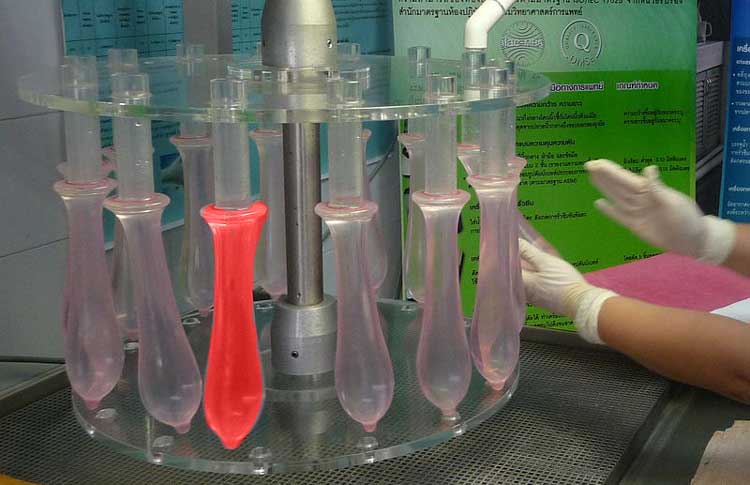Teenage Students Invent Condom That Detects STDs
HEALTH, 13 Jul 2015
True Activist – TRANSCEND Media Service
25 Jun 2015 – (Antimedia) While some American authorities scratch their heads and blame social media for a sharp uptick in syphilis, British school children have invented a condom to help reduce the proliferation of sexually transmitted infections.
Thirteen-year-old Muaz Nawaz and fourteen-year-olds Daanyaal Ali and Chirag Shah of London’s Isaac Newton Academy created a condom that changes color when it comes into contact with different types of diseases. Each infection provokes a different color response in the condom, a product of the group’s desire to “make detecting harmful STIs safer than ever before.”
The condom, named S.T. EYE reportedly glows green for chlamydia, yellow for herpes, purple for HPV—human papillomavirus, which can cause genital warts and cervical cancer—and blue for syphilis. As the Daily Mail explained, “the condom concept includes a layer impregnated with molecules that attach to the bacteria and viruses associated with the most common sexually transmitted infections.”
“We wanted to make something that make detecting harmful STIs safer than ever before, so that people can take immediate action in the privacy of their own homes without the invasive procedures at the doctors,” said Ali.
Though reports are currently unclear as to whether or not the condom recognizes infections on just the female the user sleeps with or the user, as well, the advancement represents an innovative approach to combating the spread of STDs. Further, it adds a new and unexpected level of accountability and transparency to sexual interactions. As Ali noted, “We’ve made sure we’re able to give peace of mind to users and make sure people can be even more responsible than ever before.”
The condoms were developed for TeenTech, an organization that promotes science, technology, and engineering in schools and runs an annual awards ceremony. The students won first place in the Health category. Other groups earned praise for developing various technologies, from a tool to recharge electronic devices using energy generated from walking to an electric tap to manage water in developing countries.
While glow in the dark condoms are not a panacea for sexually transmitted diseases, the fact that teenagers created it—and were encouraged by an organization dedicated to engaging youth in science—is an undeniably positive sign.
While technology can and has been manipulated by institutions and elites, in the hands of the people it can inspire transformative progress. Last year, students developed a nail polish that detects date rape drugs in drinks. In 2012, a teenage boy developed a simple, inexpensive test to screen for pancreatic cancer. Scientists now use 3D-printing to create new organs while the method will soon be able to produce low-cost food and homes, potentially revolutionizing the way societies help the disadvantaged.
Though the many ills of the world may not be healed because of glow in the dark latex, the power of young minds to create effective, innovative solutions is proving both exponential and promising.
________________________________
This article is free and open source. You have permission to republish it under a Creative Commons license with attribution to the author and TrueActivist.com.
Go to Original – trueactivist.com
DISCLAIMER: The statements, views and opinions expressed in pieces republished here are solely those of the authors and do not necessarily represent those of TMS. In accordance with title 17 U.S.C. section 107, this material is distributed without profit to those who have expressed a prior interest in receiving the included information for research and educational purposes. TMS has no affiliation whatsoever with the originator of this article nor is TMS endorsed or sponsored by the originator. “GO TO ORIGINAL” links are provided as a convenience to our readers and allow for verification of authenticity. However, as originating pages are often updated by their originating host sites, the versions posted may not match the versions our readers view when clicking the “GO TO ORIGINAL” links. This site contains copyrighted material the use of which has not always been specifically authorized by the copyright owner. We are making such material available in our efforts to advance understanding of environmental, political, human rights, economic, democracy, scientific, and social justice issues, etc. We believe this constitutes a ‘fair use’ of any such copyrighted material as provided for in section 107 of the US Copyright Law. In accordance with Title 17 U.S.C. Section 107, the material on this site is distributed without profit to those who have expressed a prior interest in receiving the included information for research and educational purposes. For more information go to: http://www.law.cornell.edu/uscode/17/107.shtml. If you wish to use copyrighted material from this site for purposes of your own that go beyond ‘fair use’, you must obtain permission from the copyright owner.
